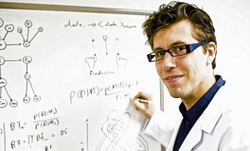
Konrad Kording, PhD, associate professor of Physical Medicine and Rehabilitation and Physiology, has launched a project to record the brain’s motor-neurons without using machinery to do it. Instead, his approach will rely on molecular-based technology to monitor nerve cells – a mouse has 100 million, including neurons – and match it to brain activity.
“If we’re successful, we’ll be able to record all of the neurons in the brain at the same time,” said Kording, principle investigator on the project and a member of the Northwestern University Center for Behavioral Intervention Technologies and Center for Engineering and Health. “No one has ever done anything that even remotely resembles this project, but if it is successful, the future of brain science will look radically different.”
The group of scientists, which includes Harvard microbiologist George Church, PhD, and Massachusetts Institute of Technology neuroscientist Ed Boyden, PhD, is working to develop an engineered enzyme (DNA polymerases) that when added to a neuron transforms it into a recording device to track nerve cell activity.
If scientists can compare and contrast what happens to neural activity both when the brain behaves normally and when it is disrupted by things like stroke, autism or Parkinson’s disease, Kording believes new treatments could be developed much more quickly.
“We previously characterized what is known as Stevenson’s Law, which shows that the number of simultaneously recorded neurons doubles every seven years,” Kording said. “If you extrapolate this into the future, it is going to take us more than 100 years to be able to record the entire brain of the mouse. Considering that figure, we started challenging ourselves to speed up the process; asking important questions for the past two years ahead of launching this project in the fall.”
Currently, brain activity in preclinical models is measured using a series of implanted electrode needles that transmit a tiny portion of neural activity to a recorder, amplifier, digitizer and computer. Kording’s project would equip scientists with the ability to study the activity of all 100 million nerve cells in concert, rather than the 100 or so random neurons which can be monitored using today’s technology.
“The current approach is like trying to understand how society works by interviewing 1,000 strangers from around the world,” Kording said. “You’ll get 1,000 people who know nothing about one another. What we want to be able to do is figure out how people communicate with their neighbors. To do this in the brain, we need to do better than 100 out of 100 million neurons.”
To begin the process of designing this “groundbreaking” enzyme, the group was recently awarded a $9 million, five-year National Institutes of Health Transformative Research grant.
“Many of the diseases that we can’t do anything about at the moment are extremely complicated; Parkinson’s disease, for example,” Kording said. “By being able to see the whole system, you would be able to see the parts and how they influence one another and begin to ask how you can minimize those detrimental effects.”






